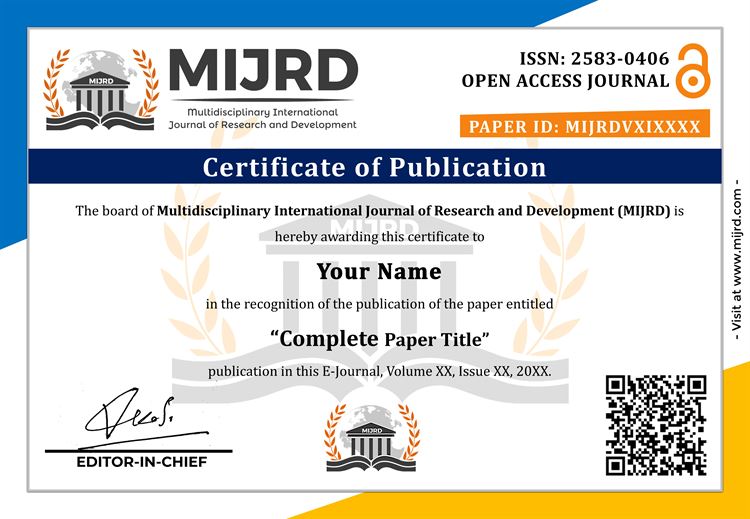Call for Papers 2025 - Fast Paper Publication
Review & Acceptance: Within 3-5 days After Submission

Publish Research & Review Papers - December 2025
- Volume: 05
- Issue: 02
- Last Date: 30 December 2025
- Frequency: Bi-Monthly
- ISSN: 2583-0406
- Fast Indexing
- Open Access
- Subject: Multidisciplinary (All Subjects)
- Language: English
- Free Certificates
- Email: editor@mijrd.com
Manuscript Publication Process
- Before manuscript submission, please download manuscript format.
- Prepare your manuscript according to MIJRD manuscript format.
- Check grammar, proper heading format, tables and figures numbering.
- References should be single format MLA, APA, Chicago, Harvard or Vancouver.
- After that manuscript checking process (Reading, Plagiarism, Content) will be in process.
- Manuscript/paper ID assignment for the author.
- Editorial review (Accepted/Minor Changes/Major Changes/Rejected)
- The final decision of acceptance will be sent to the authors.
- Authors can submit copyright transfer and agreement form with processing fee receipt.
- The final data of the article (PDF/HTML) will be prepared and published on MIJRD.com.
- After that, the author will receive final email notification of the publication with free e-certificates.
Frequently Asked Questions
A call for papers is an invitation for researchers, scholars, and professionals to submit their work to be considered for presentation at an academic conference or for publication in an academic journal or edited book. Calls are issued with information about the focus, scope, submission requirements, important dates, and review process. Researchers submit abstracts or completed manuscripts in response. The conference organizers or journal editors then select the most relevant, innovative papers to include based on peer review. Being accepted through a competitive call for papers process marks prestigious achievement for academics and helps advance knowledge exchange in that field.
Yes! MIJRD is an open access journal. Open access refers to a set of principles and a set of procedures for making research outputs available online without fee or other impediments. By using an open licence for copyright, restrictions to copying or reuse are lowered or erased when open access is precisely specified, or libre open access.
Sending work to a journal that publishes articles quickly is one approach to expedite publication. These journals can assist you in getting your work published sooner because they are intended for papers that are ready for rapid publication. Of course, before submitting your work, you still need to make sure it is of the highest caliber. On the other hand, a fast paper publication journal can be an excellent choice if you have a strong manuscript that is prepared to go.
Review papers and research papers are really different in some key ways. Research papers are way longer because they have original research that the author actually did themselves. They usually just have one author too since it’s their own work. Research papers focus on one specific research question or topic. Review papers on the other hand cover a bunch of topics by looking at what’s already been published. They normally have multiple authors who summarize and analyze earlier studies. Review papers don’t have new data, they just evaluate what’s already out there. So research papers bring new info to the table, while review papers analyze the current state of knowledge. Basically, research papers do new stuff and review papers review existing stuff. That’s the gist of the main differences between the two types of papers.
A paper’s index citation number basically shows how much that research has impacted other academics. It’s a count of how many times a paper has been referenced or cited by other scholarly works over time. So a high index citation count means the paper has gotten a ton of mentions from other researchers in the field. This suggests it’s been pretty influential and recognized for making an important contribution that’s moved knowledge forward in that area. On the flip side, a low index citation count implies the paper hasn’t been referred to as much by peers and has had a more modest effect on the discipline. The index citation metric is a good indicator of how useful fellow academics have found the paper to be for their own work. It reflects how significant the paper’s concepts and findings have been in shaping discussion and progress in that corner of research. So in simple terms, a paper’s index citation number quantifies its impact and resonance in academic circles. It shows how much the paper has shaped thinking and influenced other scholars, based on how frequently it gets brought up in the literature.
Let’s dissect double-blind peer review for those who are curious. This approach is employed by experts to ensure that a research paper or article is of the highest caliber prior to publication. Because the process is “double-blind,” the reviewers and the author remain anonymous. Think of it as a covert exam where reviewers aren’t aware of the author’s identity and vice versa.
Why? It’s all about fairness. Reviewers focus purely on the content, not who wrote it. They check for accuracy, solid ideas, and clarity. If they find any weak spots, they suggest improvements. It’s like a thorough inspection to make the work shine brighter.
In short, double-blind peer review is like a guardian of quality. It ensures that only the best, unbiased, and well-polished work reaches the public eye. It’s a vital step in the world of academic and scientific publishing.
The advantages of publishing articles in foreign journals:
1. Impact and Worldwide Visibility: Your research will become more widely known when it is published in foreign journals. A wider range of people, including other researchers, academics, professionals, and policymakers worldwide, are impacted by your work.
2. Academic Credibility: International journals have a reputation for having strict peer review procedures. Having your work accepted shows how good and reliable your research is, which improves your standing in the academic community.
3. Dissemination of Knowledge: Publishing your research in international journals helps spread knowledge. It promotes a collaborative atmosphere that quickens progress by assisting other researchers in building upon your findings.
4. Possibilities for Networking: Publishing in international journals can help you get in touch with researchers who work in related fields. This networking may result in discussions, partnerships, and idea sharing that advance your scientific endeavors.
5. Career Advancement: For academics, one of the main requirements for career advancement is often publication in prestigious international journals. Promotions, tenure, and other career chances are possible outcomes.
6. Contribution to the Field: The advancement of your field can benefit greatly from your research. International journals offer a forum for the presentation of creative concepts and breakthroughs that can spur progress. Optimization of Keywords: Here are 10 ways to make the article more search engine friendly.












